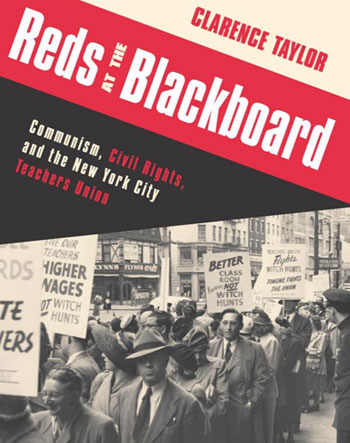
Nearly 25 years after the collapse of the Soviet Union and the end of the Cold War, more and more historians are beginning to paint a more objective, balanced and – in many cases – positive picture of the role of communists and the Communist Party, USA in the U.S. labor movement.
Clarence Taylor’s Reds At The Blackboard: Communism, Civil Rights and the New York City Teachers Union is a welcome addition to U.S. labor and communist history.
Taylor begins Reds At The Blackboard by highlighting the work of a small group of CPUSA members to democratically win leadership of the Teachers’ Union as early as 1923. Through their Rank and File Caucus, by 1937, Party members had won fifteen of twenty-four seats on the union’s executive board, and headed up many of the union’s leadership committees – including, Academic Freedom, Anti-War/Anti-Fascist, Educational Policies, Legal Aid and Grievance, Membership and the editorship of the New York Teacher News, the TU’s newspaper.
Though they faced internal and external opposition, the TU, under Party leadership, fought for and built a unique form of democratic “social unionism” that lead to a dramatic increase in union membership – from about 1,500 members in 1935 to a peak membership of about 6,200 in 1938, “making it the largest teachers union in the city and proving that the union’s work was attracting teachers.”
Like many other communist-led unions, the TU championed civil rights and “diligently supported the black freedom struggle.” This is probably one of the most important contributions Taylor makes to the historiography of the communist-led TU and its role as a broad-based civil rights union fighting for full equality long before the emergence of the 1960’s era civil rights movement.
By challenging Board of Education-approved racist textbooks the union “promoted black history and culture” and “highlight[ed] the role played by people of African origin in making America a great country.” Additionally, the union brought black and white teachers, substitute and full-time, together and “argued that the fight against racism was important because racial discrimination not only hurt blacks but was also harmful to whites…”
That the TU “established a counseling service for black prospective teachers,” “support[ed] black applicants attempting to secure teaching licenses” and “help[ed] black applicants prepare for the written [teaching license] tests,” while “assist[ing] them in appealing unfavorable ratings” and helping to “place them in [teaching] vacancies” illustrates a commitment to affirmative action long before it became a mass rallying cry and highlights the vanguard role of CPUSA members in challenging institutional racism.
Throughout World War II, the TU’s fight against racism intensified as it equated racism to Nazism and argued that “racism was un-American.” In fact, the “union positioned the struggle for racial equality in a broad context, making fighting fascism, anti-Semitism, and other forms of discrimination synonymous with patriotism. Consequently, for the TU, antiracism became integrally linked to America’s war effort.”
After the war, the TU continued to fight for racial equality for teachers. Starting in 1949 “…the union’s Committee Against Discrimination” conducted surveys “on the racial makeup of school faculties…,” which were “the first systematic attempt to gain insight into hiring patterns” in New York City schools. The 1949 survey, along with another more detailed 1951 survey, “charged” the board of education with a “consistent pattern of discrimination” and argued that “the absence of Negro teachers on the faculty undermines the concept of democracy and equality that our schools should offer the children…”
By 1955, the union released another survey on Black employment in the schools; it found that of the 16,000 teachers included in the survey, there were only 312 “regularly appointed” and 232 “substitute black teachers.” Obviously, the board of education had done very little to remedy its institutional racism, which lead the union to assert, the “present teacher employment situation…constitutes an injustice not only to Negroes but also to the white children of the city…”
Taylor’s Reds At The Blackboard also focuses on the board of education’s purging of communists and progressives by claiming that the TU was Moscow-controlled. “By depicting the union as a group working on behalf of Moscow, the board and the union’s enemies launched a campaign to strip the TU of its right to represent teachers before management,” while unconstitutionally taking away the right of teachers to elect representatives of their own choosing, effectively decertifying the union. In fact, by May 1955, “two hundred thirty-nine teachers and other board personnel had been forced out of the [school] system,” due to the purges. One teacher even committed suicide.
A lot more could be written about the board of education’s purging of communists, as well as, the blatant anti-Semitism surrounding the purge than can fit into a short review. Suffice it to say, Taylor writes on these subjects in detail.
In all, Reds At The Blackboard is an important and welcome contribution to U.S. labor and communist history; the emphasis on the TU’s work against racism and for full equality is especially illuminating. Reds At The Blackboard is highly recommended.
“Reds At The Blackboard: Communism, Civil Rights, and the New York City Teachers Union”
Clarence Taylor
Columbia University Press, 2011, 372 pages










